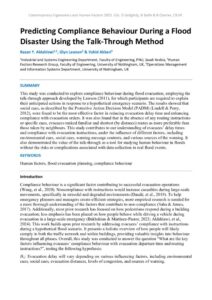| Document | Author Razan Y. Aldahlawi1,2, Glyn Lawson2 & Vahid Akbari3 |
| Abstract This study was conducted to explore compliance behaviour during flood evacuation, employing the talk-through approach developed by Lawson (2011), for which participants are required to explain their anticipated actions in response to a hypothetical emergency scenario. The results showed that social cues, as described by the Protective Action Decision Model (PADM) (Lindell & Perry, 2012), were found to be the most effective factor in reducing evacuation delay time and enhancing compliance with evacuation orders. It was also found that in the absence of any routing instructions or specific cues, evacuees ranked familiar and shortest (by distance) routes as more preferable than those taken by neighbours. This study contributes to our understanding of evacuees’ delay times and compliance with evacuation instructions, under the influence of different factors, including environmental cues, social cues, warning message contents, and various sources of the warning. It also demonstrated the value of the talk-through as a tool for studying human behaviour in floods without the risks or complications associated with data collection in real flood events. |

